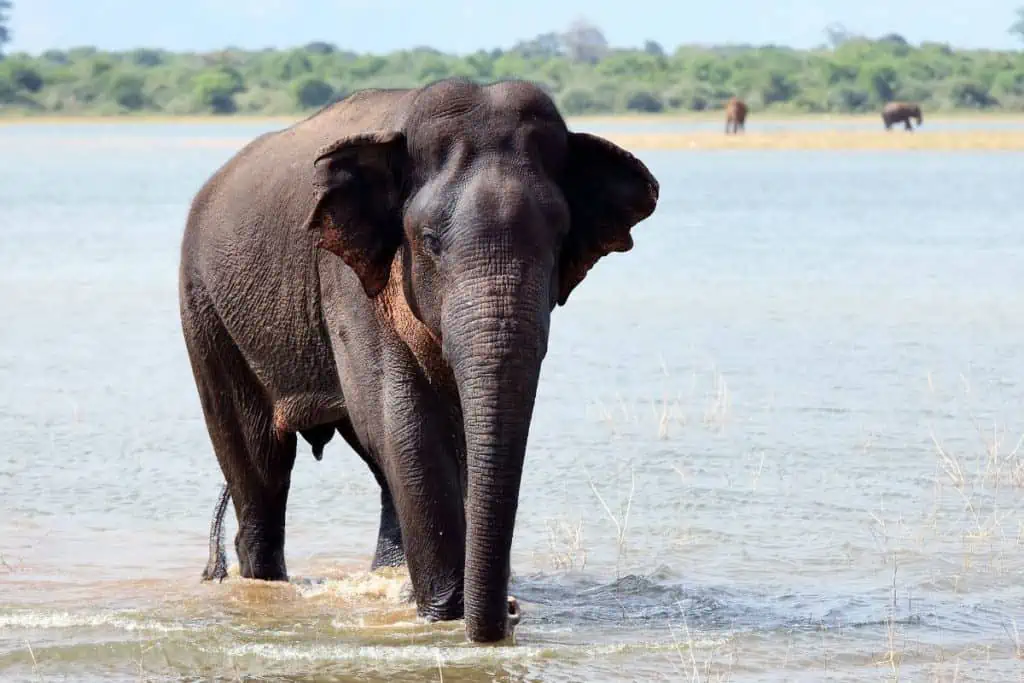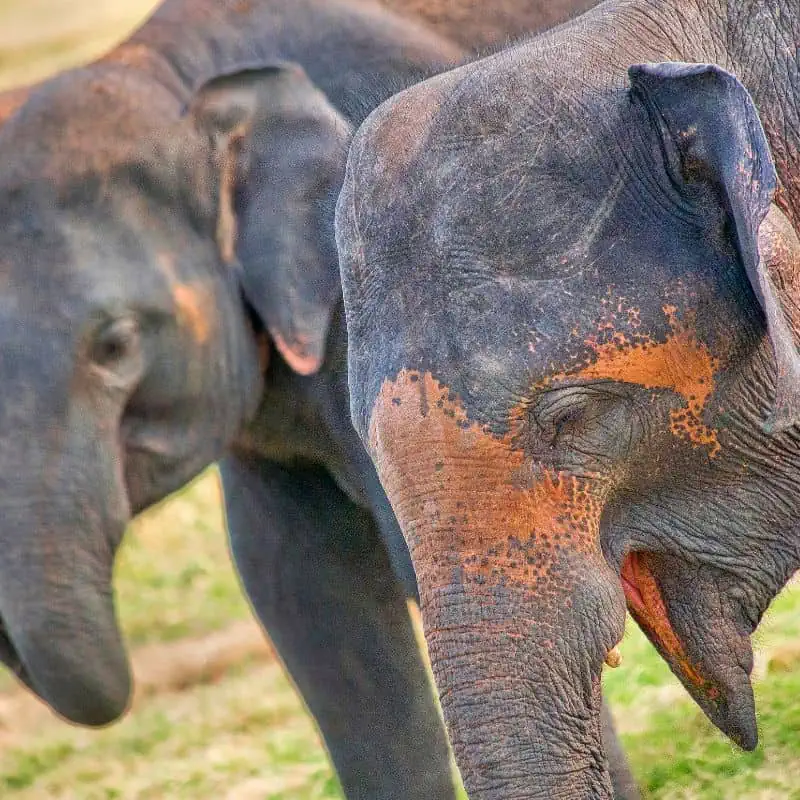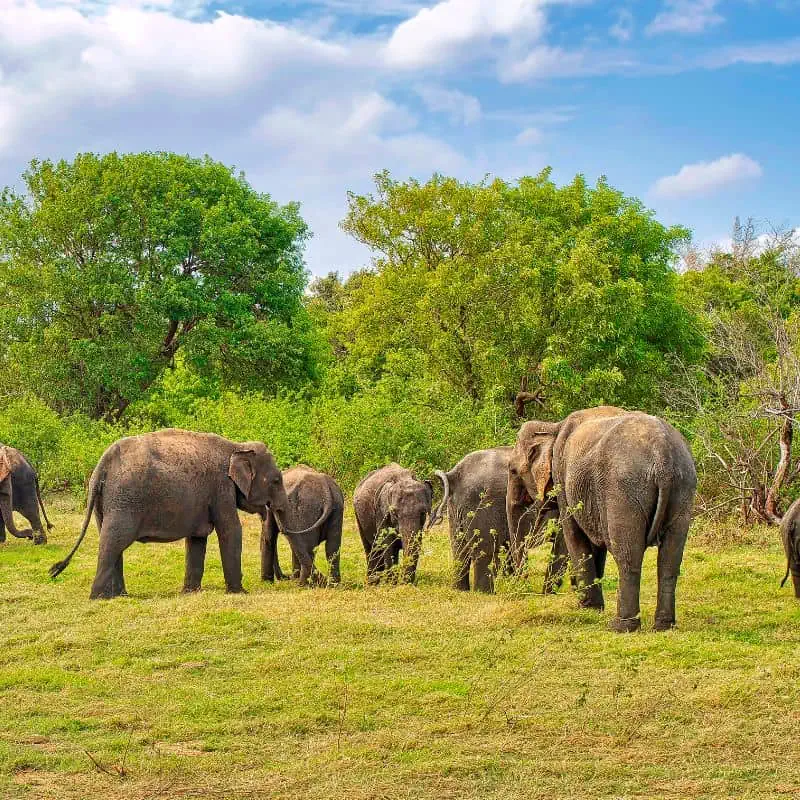You may have heard of Sri Lankan elephants, a subgroup of Asian elephants. Their location hides in their name – Sri Lanka, particularly in the north, east and Southeast regions. You might think that these animals are just another subcategory, but no, they put on quite a show when it comes to impressive features.
Here are five surprising facts about Sri Lankan Elephants:
- They can attain a top speed of 43 Km/h.
- Their life expectancy is 55 to 70 years.
- Their body contains patches with no skin color at all.
- They can weigh from 4,400 lbs to 12,000 lbs.
- According to Sri Lankan law, hunting a Sri Lankan elephant is prohibited, leading straight to the death penalty.
In this article, we’ll look at everything you didn’t know about Sri Lankan elephants, so let’s dive in.

5 Facts About The Appearance of Sri Lankan Elephants
These giant beings are quite different from other types of elephant species.
Here are a few facts regarding a Sri Lankan elephant’s appearance which will blow your mind:
- The Sri Lankan elephants are among a handful of species that can recognize themselves in the mirror.
- These elephants have the largest brain among all terrestrial mammals. This contributes to the increased level of intelligence that Sri Lankan elephants have.
- The trunk of an elephant contains numerous nerve endings. Therefore, Sri Lankan elephants fear tiny creatures such as bees and ants. Imagine being this massive but having a serious disadvantage over shorter beings.
- Sri Lankan elephants possess thick skin. The thickness of their skin ranges up to 1 inch. However, a downside of having such a thick layer is sensitivity to the sun. To work their way around this, Sri Lankan elephants cover themselves in mud or dust.
- These elephants have earned the title of one of the largest Asian elephants – having the ability to reach a shoulder height of 10 feet.

5 Facts About The Mating Habits of Sri Lankan Elephants
Where other animals have a specific period for mating, these elephants break the tradition.
Following are some surprising facts regarding the mating habits of Sri Lankan elephants:
- From the males, only the dominant Sri Lankan elephants or ‘bulls’ can reproduce with the female. In this case, the non-dominant ones have to wait for their turn.
- The female version of Sri Lankan elephants becomes sexually mature at age ten.
- A single pregnancy lasts for 22 months in Sri Lankan elephants – resulting in the birth of one offspring.
- Sri Lankan elephants don’t have a particular mating season or period. Therefore, they can mate at any time of the year.
- Male Sri Lankan elephants don’t help out in raising the newly-born elephant. As a matter of fact, they disperse. This leaves only the mother and other adult females to care for the baby.
5 Facts About Newly-Born Sri Lankan Elephants
A baby Sri Lankan elephant is full of interesting facts as well, which are as follows:
- A baby Sri Lankan elephant is referred to as a Calf.
- A newly-born Sri Lankan elephant weighs between 91 to 114 kilograms.
- The largest newly-born Sri Lankan elephant is said to have reached a weight of 148 kilograms! This historical event occurred on May 12, 2020, at Houston Zoo.
- A calf achieves its independence after it becomes five years old. Until then, the baby elephant resides with its mother.
- After birth, the newly-born elephant doesn’t possess muscles in its trunks; therefore, it must use its mouth until the trunk develops.
5 Facts About The Diet of a Sri Lankan Elephant
An animal as big as a Sri Lankan elephant must have a beastly diet, and rightfully so.
Here are some diet-related facts about Sri Lankan elephants:
- Sri Lankan elephants are herbivores or vegetable-eating mammals.
- Their diet mainly includes grasses and vegetables such as bark, fruits, roots, nuts, and seeds.
- A fully-grown Sri Lankan elephant eats up to 300 to 400 pounds of food every day!
- Sri Lankan elephants are fond of a wide range of plants – these elephants eat up nearly 60 to 70% of plant species.
- Sri Lankan elephants became the largest subgroup of Asian elephants when an elephant went above the 12-000 pound mark.
5 Facts About The Population of Sri Lankan Elephants
Some facts regarding these elephants are tragic as well, such as the ones listed below:
- The status of Sri Lankan elephants has now become endangered.
- According to an elephant expert in Sri Lanka, nearly 4,000 wild elephants were left in 2021.
- There are almost 200 to 250 elephants in captivity.
- During the 19th century, Sri Lanka was home to around 19,500 elephants, and the numbers have dropped significantly since then.
- The Sri Lankan Department of Wildlife Conservation predicted the storing capacity of the National Park and the remaining forests – the numbers tallied from 4,000 to 5,000.

Final Thoughts on Sri Lankan Elephants
Sri Lankan elephants, or Elephas maximus, are a subgroup of Asian elephants. These elephants reside in specific dry zones in Sri Lanka and are known to be one of the largest terrestrial mammals on earth.
Apart from their large size, these elephants display impressive features in various biological aspects such as diet, reproduction, appearance, and more.
However, these elephants have sadly become endangered due to recent human activities and the loss of forest land in Sri Lanka.
FAQs
How Many Sri Lankan Elephants are Left?
The number of Sri Lankan elephants was 19,500 during the 19th century. However, this amount decreased significantly during the start of the 20th century and onwards. An approximate 65% decrease came in the total number of Sri Lankan elephants after the 19th century, and in 2021, an estimated 4,000 elephants were left.
Are Sri Lankan Elephants Endangered?
Yes, due to recent human activities and the reduction of forest land. Both these factors have contributed to restricting the grounds available for Sri Lankan elephants to live. As of 2021, only 4,000 Sri Lankan elephants were left. Keeping in view the current situation, the Sri Lankan Government has banned the hunting of these elephants.

